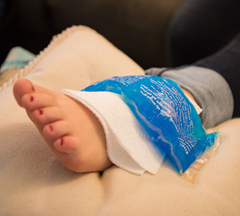- Bone and Joint Health
- Fitness and Exercise
- Health Topics
- Joint Conditions/Injuries/Treatment
- Joint Pain/Pain Management
- Your Family's Health
Strains And Sprains. What a Pain!

Answer a few questions and we'll provide you with a list of primary care providers that best fit your needs.
When the weather warms up, you and your family probably return to outside activities, like a favorite sport or hobby.
Sometimes, getting back into an activity after time away or overexerting yourself — especially in extreme weather — can lead to muscle pulls and pains.
When muscles, tendons, or the ligaments near your bones and joints stretch too far or tear, pain, bruising, and swelling happen. These soft tissue injuries take time to heal, but they don’t have to put a damper on outdoor fun.
Whether that’s your child’s sports team, gardening, or a weekend hike, you can take steps to avoid sprains and strains that can slow you down.
What Is a Strain?
Muscle strains are common injuries that can be mild, moderate, or severe. You may hear the these injuries called pulled muscles because they happen when a muscle or tendon stretches or tears.
Strains can occur suddenly or develop over time. Twisting or pulling a muscle or tendon can cause a strain. They occur often while you’re playing sports.
Sudden strains may make a popping sound and can be caused by:
- An intense workout
- A recent injury
- Lifting heavy objects the wrong way
- Overstressing muscles
Repetitive use of the same muscles or tendons can cause strains to develop over time.
Pain is the most common sign of a strain. Other symptoms include:
- Muscle spasms
- Muscle weakness
- Swelling
- Cramping
- Trouble moving the muscle
- Extreme pain and difficulty moving if the muscle is torn
Strains most often affect the muscles and tendons in the:
- Lower back
- Neck
- Shoulder
- Hamstring (back of the thigh)
- Thumb (mommy thumb)
If the injury is mild, you can usually care for it on your own.
What Is a Sprain?
A sprain happens when a ligament that connects bones together in a joint is stretched, pulled, or torn. Movements that force a joint out of its normal range of motion cause a sprain. You may feel a tear or pop when the injury happens, most often from:
- Falling
- Twisting
- A forceful hit (like a football tackle)
- Falling and landing on an arm
- Falling on the side of your foot
- Twisting a knee
Sprains can be mild, moderate, or severe. The signs that suggest a sprain include:
- Pain
- Swelling
- Bruising
- Not being able to move the joint
Common sprain injuries involve the:
- Ankle, from falls or playing sports
- Wrist, often injured in a fall by landing on the hand
- Thumb, common in skiing and other sports
Treating Pulled Muscles And Injured Joints

If you sprain or strain a muscle or joint, treatment is important for proper healing and to avoid future injuries. The approach for strains and sprains is the same. If the injury is mild, you can usually care for it on your own. Icing the injury is always a safe bet.
The most effective treatment is the RICE method. In the first few days after an injury, you should:
- Rest the area you injured. Your doctor may recommend crutches if you hurt your knee, foot, or ankle.
- Ice the injury for 20 minutes at a time, several times a day.
- Compress the injury with bandages or a splint to reduce pain and swelling. Your doctor might also recommend a cast or boot.
- Elevate the injury (arm, leg, elbow, knee, etc.) on a pillow, to reduce swelling.
Treating pain. To treat pain, your doctor may recommend over-the-counter remedies such as aspirin or ibuprofen.
Surgery. In severe cases, where a muscle, tendon or ligament is torn, surgery may be needed to help you regain full use of the injured area.
Be sure to see a doctor if your injury is extremely painful so that you receive the proper treatment.
16 Ways To Prevent a Muscle Injury
You can avoid sprains and strains by preparing for physical activity and listening to your body — especially if you’ve already injured a muscle, tendon, or ligament:
- Stretch your muscles every day.
- Warm up before exercise or intense activity.
- Exercise at least five to six days per week.
- Cross-train for sports by weightlifting or doing another activity to strengthen muscles.
- Be in proper physical condition to play a sport.
- Do not exercise or play sports when you are tired or in pain.
- Wear protective equipment when playing a sport.
- Stay hydrated during exercise.
- Eat a well-balanced diet to help repair and keep muscles strong.
- Eat foods that are nutrient-dense before exercise to prevent muscle fatigue.
- Maintain a healthy weight.
- Wear shoes that fit well.
- Get new shoes if the heel wears down on one side.
- Run on flat surfaces.
- Take precautions to avoid falling (use sand or salt on icy spots on your front steps or sidewalks).
- Allow proper time to heal from an injury.
If you regularly pull muscles or injure your joints, talk with your doctor about how to stay active and prevent a re-injury.
Answer a few questions and we'll provide you with a list of primary care providers that best fit your needs.
Source: American Academy of Orthopedic Surgeons; Healthline; National Institute of Arthritis and Musculoskeletal and Skin Diseases




